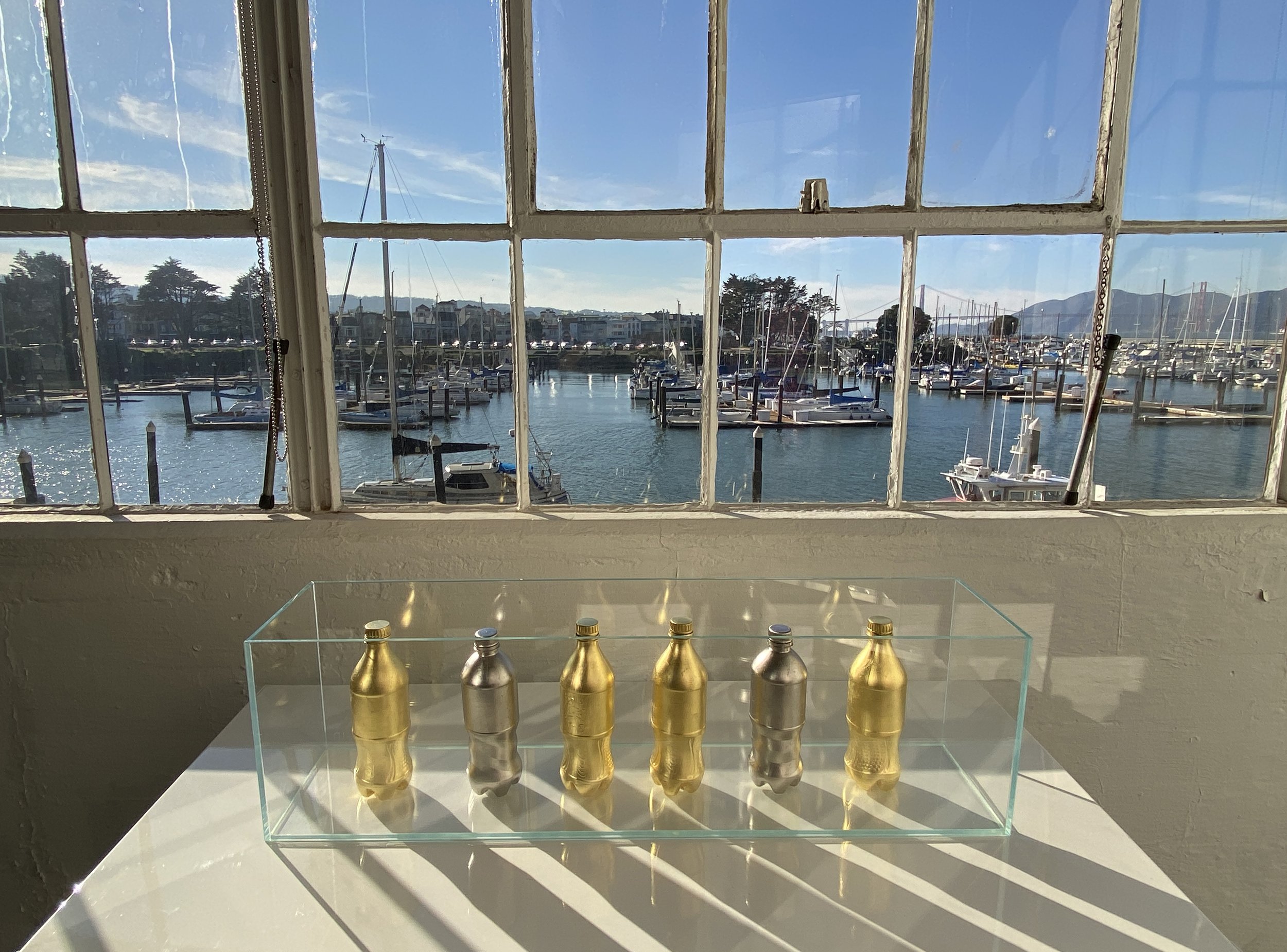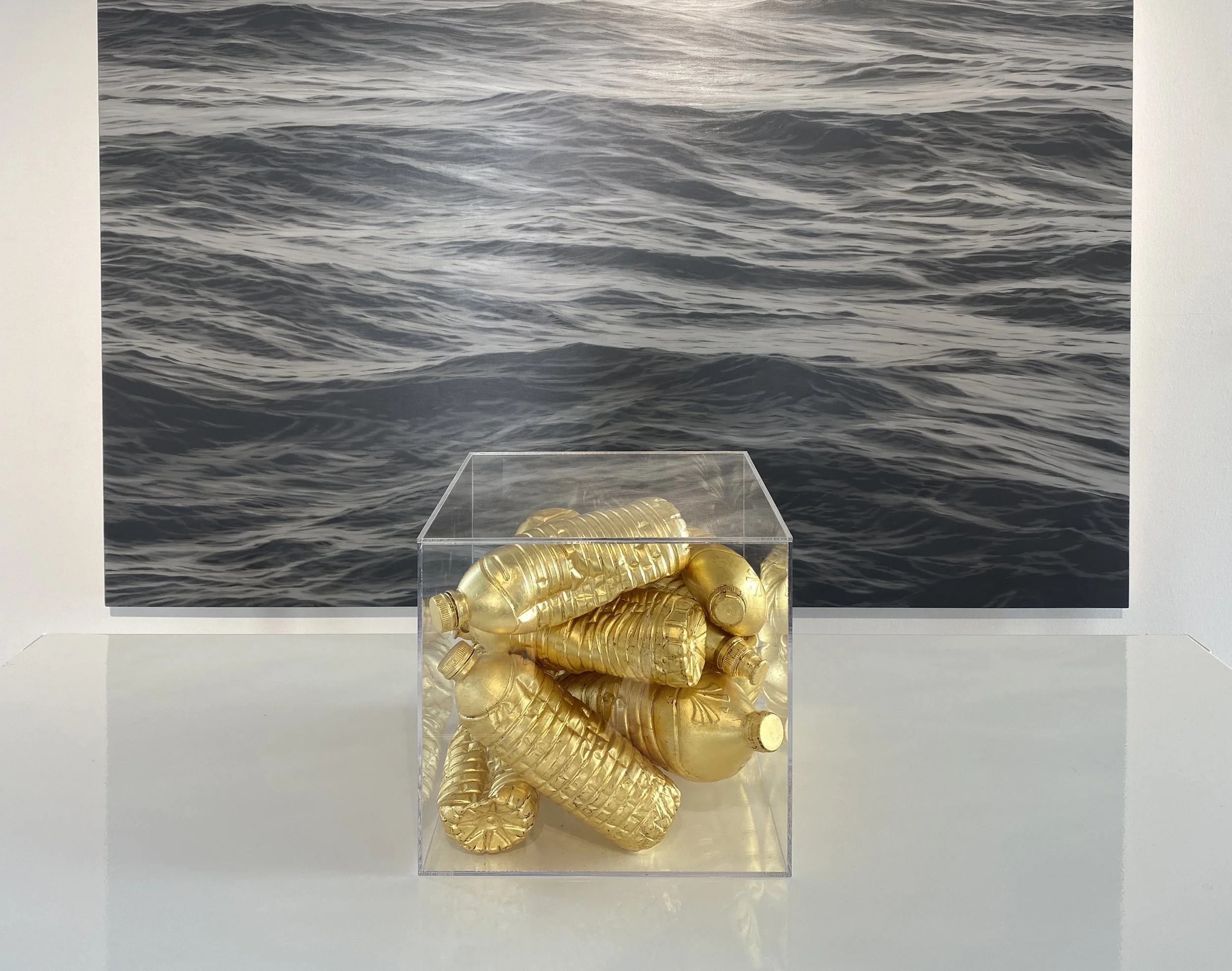
Aquaria of the Plastocene
A Virtual Exhibit
Created by Katherine B. Young
We live in the Plastocene Era, otherwise known as the Age of Plastics.
Despite awareness of the ocean plastic crisis, the world increases its plastic production every year. Less than 10% of this is recycled.
Artwork
My intention is to create artworks that increase mindfulness about our plastic use, and inspire us to look at the challenge in a creative way.
This series consist of real (and imagined) aquariums. But instead of being filled with marine life, they are filled with discarded single-use plastic, which is coated with genuine gold leaf to draw attention to the plastic, and to examine the idea of value. Each aquarium tells a unique story about plastic pollution. These aquaria are surrounded by large ocean paintings and drawings to juxtapose our different values — peace, nature, convenience, and money. What do we really treasure most? What does our culture of convenience actually cost us?









Exhibition
-

The New Coal with oil painting Fathom
-

-

Crystal Geyser Collection with oil painting Fathom
-

Crystal Geyser Collection with graphite drawing Crescendo
-

Coke or Pepsi? with graphite drawing Crescendo
-

-

Close up of Crystal Geyser Collection
-

Close up of 2050
Individual Aquaria
2050
23 Kt Gold Leafed Plastic Bottle and Vintage Fish Bowl
2050 is the year that it’s estimated we will have more plastic than fish in our oceans if we don’t cut back our plastic use
Coke or Pepsi?
23 Kt Gold Coca-Cola bottles, Silver Pepsi Bottles, Glass Aquarium 36 x 9 x 11” , with graphite drawing
Coca-Cola wins the gold and Pepsi takes the silver as the two leading plastic polluters in the world.
The New Coal
23 Kt Gold Leafed plastic water bottles and vintage coal scuttle 11 x 20”
Plastic is made from fossil fuels, and the US is in the process of bringing 42 new plastic refineries online. According to the oil industry’s own greenhouse gas emissions data, this is like adding 27 new coal plants. Most of these plastic refineries are situated near low income communities, like the notorious Cancer Alley in Louisiana. Plastic is becoming the new coal.
Crystal Geyser Collection
Nine 23 Kt gold leafed plastic Crystal Geyser water bottles in aquarium
Crystal Geyser happened to be the most common brand of plastic water bottles I found as litter. The EPA estimates that about 9% of our plastic waste is recycled in the US. The remainder goes to landfills or incineration, where they emit greenhouse gases and other toxic emissions. And of course, some end up in the ocean.
Wishcycling
23 Kt gold leafed plastic waste and blue plastic recycling bin
Wishcycling is when people put things in the recycling bin that they hope will be recycled. Just because something has the chasing arrows doesn’t mean it can or will be recycled. None of the containers in this artwork are typically recycled—they consist of #5 (yogurt tub), #6 (sushi trays), #7 plastic (Florida’s Natural orange juice) and a Starbucks cup (layered paper and plastic—not recyclable or compostable).
Grab-N-Go
23 Kt gold leafed non-recyclable single-use food items, wood and plexiglass counter case
These single use items are all made from plastic that is not recycled. Despite the chasing arrows sign on the bottom of the #5 plastic containers in this display, #5 plastic is almost never recycled in the US. The coffee bag and food wrappers have plastic linings and are not recyclable either. They will end up in landfills, incinerators, and the ocean.
These items may be convenient, but are they really affordable? Perhaps up front, but the long term costs of disposal and environmental damage are much higher.
FAQ
Why make artwork about plastic?
My art has always been focused on the ocean, channeling its vast and peaceful qualities. It is impossible these days to consider the ocean and not think about the plastic pollution problem. I feel heartbroken every time I see a story about the devastation plastic is wreaking on our oceans. Plastic is found in every part of the ocean and it doesn’t go away. It breaks down into micro-plastics, which float, attract toxins, and are eaten by creatures great and small. Seabirds and marine mammals are dying with stomachs filled with plastic trash. The micro-plastics and their associated toxins are ingested by fish, and enter our human food supply. Furthermore, plastics generate more and more greenhouse gases every year, which contribute to ocean acidification and warming.
But instead of reducing our plastic consumption, we are increasing plastic production every year. in 2019, the world created over 350 million tons of new plastic, and approximately half of this is single-use plastic. Less than 10% of plastic is recycled. The rest ends up in landfills, incinerators, or the ocean. The vastness of the ocean inspires my art, but I began to wonder—are our oceans vast enough for all of this?
Why Aquariums?
An aquarium can be a beautiful aquatic scenario, filled with fish and plants, creating a vibrant simulation of ocean life. My aquaria are filled with plastic instead, which is the direction we are headed if we don’t change our plastic consumption habits. Ocean plastic is harming all forms of marine life, from plankton to whales. The Ellen MacArthur Foundation reports that if we don’t change our plastic consumption habits, there will be more plastic than fish in the ocean by 2050.
Why use gold?
I have used gold leaf in my artwork for many years to represent the sublime and the spiritual qualities of nature.
At the beginning of the project, I saw that plastic trash and gold have some things in common. Both are shiny, malleable, attractive, and can last for centuries. Gold we value, yet plastic we throw away after seconds of use. It’s absurd that we discard all of this plastic so mindlessly. Gold-leafing this plastic waste highlights this absurdity.
One of the other problems with plastic is that it has become such a common presence in our everyday lives that we often don’t even notice it. Coating it in gold brings it sharply into focus, making us pay attention.
Gold is also a symbol of money and value, which are both drivers of the plastic pollution problem. Plastic is very cheap, profitable and convenient. I want the artwork to help us think about what we really value. What is the true cost of our consumer culture of convenience?
Where did the plastic waste come from ?
All of the plastic bottles for the project were found in nature, sadly. The non-recyclable plastic items were recovered from the trash bins of friends and family.








